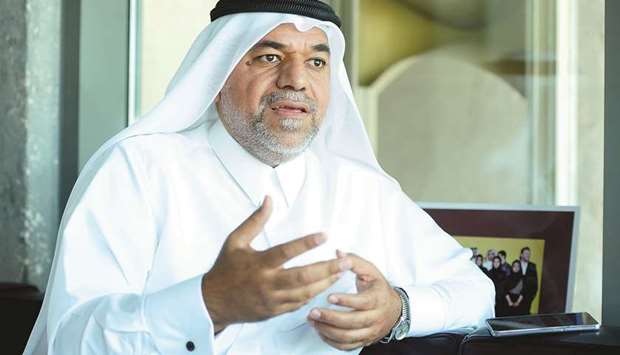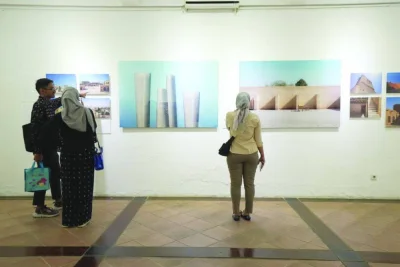Tell us about yourself.
I have been a passionate photographer all my life. The journey actually started when my father gifted me a camera, Kodak 110, in 1977 when I was, I think, six years old. I still have it. The real spark came when I was in high school. I played for the Qatar national volleyball team and had to travel a lot. Whenever I travelled, I would carry my camera.
Currently, I am Director Artist-in-Residence programme at Fire Station. It was started three years ago and this year it will have its fourth session. We gather 18 artists for the programme every year, half of them Qatar nationals and other half Qatar residents. The nine-month-long programme includes video, photography, paintings, sculptures and other art. The programmes are concluded with group exhibitions of the artists’ works.
I have also developed another programme here. We offer it in summer for two months where 10 students, selected from different schools, learn art works.
How do you manage to have time for photography, then?
Photography is a stress releaser for me. It is a relief after long working hours. For this reason, I find time to carry my camera that I love. I keep my camera in my office. I still use old films for photography. It is more tangible away from digital photographs. I enjoy this.
Every Friday morning at 5:30am, I go out with a group of photographers. We go to Souq Waqif and around the neighbourhood for photos. It is a diverse group of photographers from different nationalities. The photographers come from different backgrounds – working at some senior post or simply as labourers. We capture everyday life and other related activities. After the activity, we come back to Souq Waqif and have breakfast together.
How has the art transformed since the ‘70s’?
I joined Qatar Photographic Society in 1988. There were many famous Qatari photographers and some of them were real masters. They taught us and we got basic technique and line of photography from them. Their line is alive and kicking even today. Whenever I see their photos, I recognise who the photographer is!
We tried to mentor and direct many photographers. But, unfortunately they are not serious. They want to become famous overnight. They do funny things just to be known; they do not know but they harm themselves. They just do not know how to do it.
Are there crash courses for photography at Fire Station?
At Fire Station, we do have some community courses. But these are not focused only on photography. These are related to general art practices. Lately, we did programmes exchanging photographers between Qatar and other countries. The pivot was the ‘Year of Culture’ programme. Every year, there is collaboration with one country. This year, Qatar is collaborating with Russia. Two photographers are going from Qatar to Russia and, vice versa. Then, there will be an exhibition. Next year, we will have a similar venture with India.
I think this is not enough. We need to do more. Every year, we invite artists for residency programme. About 190 to 200 people apply and the photographers are only may be two percent. To conclude, people like photography, but do not have the patience to learn it.
Has digitalisation made photography any easier?
Everybody thinks that photography is easy but in fact, it is not. It is the most difficult art to follow. Among a million photos, there may be four to five effective photos. It is very difficult to bring that moment (in the camera) for the people.
Earlier, photographers used to have analog camera with films having a certain number of photos. Photographers used to have focus and attention about what they wanted to pursue. Now, you have 1,000 photos in your camera. You can click and see without any fruitful thought. The end result is that “I can delete”. I can take 200 photos to have two or three effective ones.
Think about it: Why do specialised war photographers fetch valuable images? They will go and study the situation. They read life and people around them. They will, then, capture certain moments. They do not go by chance and get what they get. That is the kind of feeling and spirit needed to do good photography. How many people can wait for a good shot? It is not available here and there. It is within us. If it is not, you cannot take a great photo. A photo is, essentially, a reflection of you.
What one good piece of advice will you share with the young? Photography is an idea and a message. My suggestion to the young generation is that they should ask themselves before they take a photo: What is my aim? What do I need from this photo? Then, they can really focus on what they really want. From there, they can aspire for a candid expression. They should not take a photo just for the sake of it.
Is there any positive side to digital photography in your opinion?
I also use digital cameras. We are living in a revolution. Everyone has a digital camera. I have learnt how to handle new technology. I understand the behaviour of a digital camera. Sensors that have replaced the old films have completely different behaviour for lighting and colours.
The young generation needs to learn the new technology. Actually, all the information is available on the Internet. But we need somebody to dig in. I have myself benefited enormously from digital technology. I also teach how to use digital camera in the best way possible. The new technology is amazing. You can take a photo, edit it and send it within no time. We have to use this technology to express ourselves. I plan to have a small programme for young photographers in the near future.
Have you organised exhibitions highlighting your work?
I have organised exhibitions in many countries around the world. My photographs on Qatar have received appreciation all around the world. A photography exhibition, done with a lot of hard work, does get the eyeballs.
What kind of objects do you often capture?
I like to photograph people. I always like people around me. I love to photograph local people, who live a natural life. I like people who are more close to themselves. I also like photographing workers and people in streets.
What are your plans for the future?
I think I have a message to deliver through my photography. I want to show what Qatar is and how people live here. My photos reflect people and life in a natural setting. I also want to capture the fast developments taking place in Qatar.

MANTRA: u201cMy photos reflect people and life in a natural setting,u201d says Khalifa Ahmad al-Obaidly. Photo by Ram Chand


